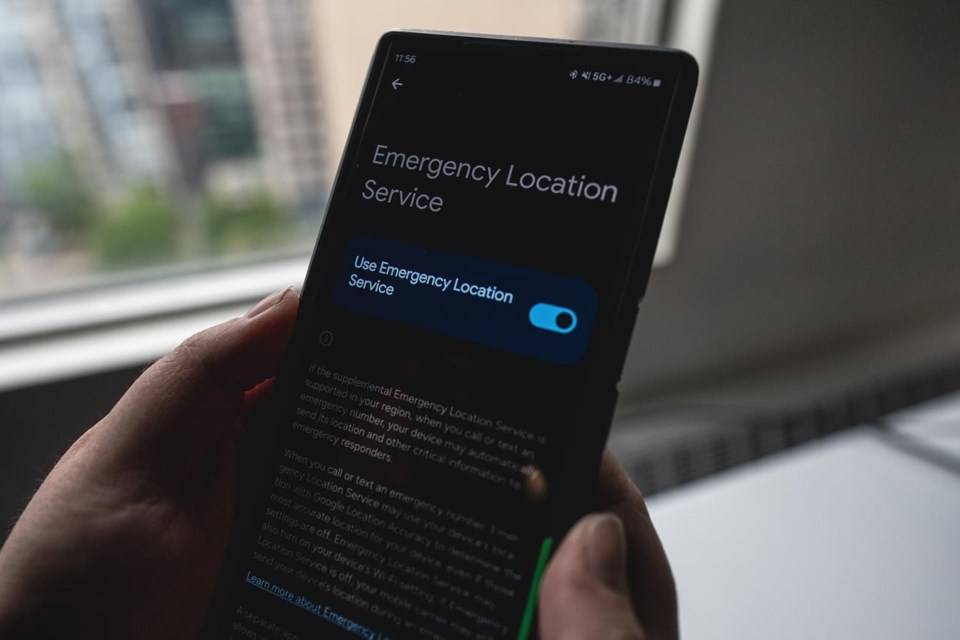TORONTO — Next time Android users in Canada make a 911 call, a new service embedded in their phones will transmit their location to emergency responders.
Google announced the debut of Android's Emergency Location Service in Canada on Monday, saying its goal is to reduce response times by helping emergency personnel locate people in need quicker.
"This is such a critical service to users because so often a call taker wouldn't have gotten the location they needed to quickly and easily dispatch that help, so this is ... a huge help to Canadian folks who are calling emergency services," said Boone Spooner, a group product manager for Android safety at Google.
The service's Canadian launch comes as the telecommunications industry, its regulator and tech companies are working toward overhauling aging emergency systems, so they're capable of collecting more information in a broader range of formats from Canadians in distress.
Their aim is to transform the systems from analog to digital so the country can offer next-generation 911 services, which could eventually see first responders receive text messages, medical information or even videos of emergency incidents.
The Emergency Location Service's origins date back to 2018, said Spooner.
"A developer on Android had an emergency and realized that the dispatcher didn't know where she was," he said.
"She thought 'There must be a way that I can solve this problem.'"
At the time, 911 services were able to locate callers either through landline technology or by asking someone where they were, a question that sometimes wasn't easy to answer.
"Maybe they didn't know where they were or any landmarks in order to get that help sent to them," Spooner said.
The service reduces such issues because it relies on a combination of Wi-Fi, GPS, and cell towers to pinpoint where a caller is.
"The call taker will see a blue dot similar to what you would see on Google maps and that dot is the XY co-ordinates of the location of the user placing their phone call from," said Spooner.
"A dispatcher can then determine based on that blue dot or that location, the cross streets or the building that that user is in."
Elevation information is also transmitted, so a dispatcher might be able to get a rough idea of what floor a caller is on, if they are inside.
The service only gets activated when 911 is called and because the feature will only be used by emergency service providers, Google says it will never see nor handle users' locations. Android users will have the ability to opt out of the service, Spooner added.
Google estimates the service, which is free, will be available on 99.9 per cent of Android phones that are version five or newer.
Access to the service is not reliant on what cell service provider you subscribe to, though Google partnered with BCE Inc. and Telus Corp. for the launch because the telecommunications firms are the country's 911 network providers.
As a result of the launch, Canadian Radio-television and Telecommunications Commission records show Telus and BCE are seeking permission to charge other wireless service providers $0.0073 per subscriber per month to recover the cost of deploying the Emergency Location Service.
The service comes as the telecommunications industry has seen its emergency efforts in the spotlight more in recent years after millions of Canadians were unable to reach police, paramedic and fire services when Rogers Communications Inc. had a widespread service interruption in July 2022.
Though Bell and Telus offered assistance to its rival during the disruption, Rogers couldn’t transfer customers to competing carriers and was unable to automatically connect customers to another carrier for 911 calls.
In an effort to reduce the odds of such a situation repeating itself, the federal government ordered the telecom companies to develop a backup plan.
Amid those conversations, Apple brought its Emergency SOS system to some iPhones in November 2022. The system helps people without cellular or Wi-Fi service connect to a satellite to report an emergency or call for help in even the most remote locations.
This report by The Canadian Press was first published May 13, 2024.
Companies in this story: (TSX:BCE; TSX:T)
Tara Deschamps, The Canadian Press

